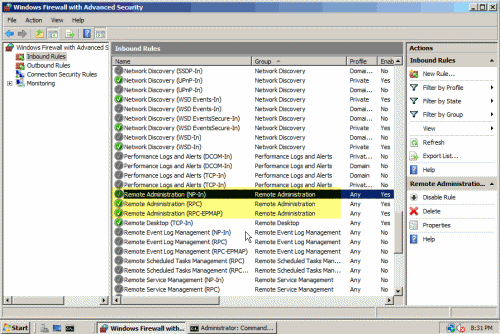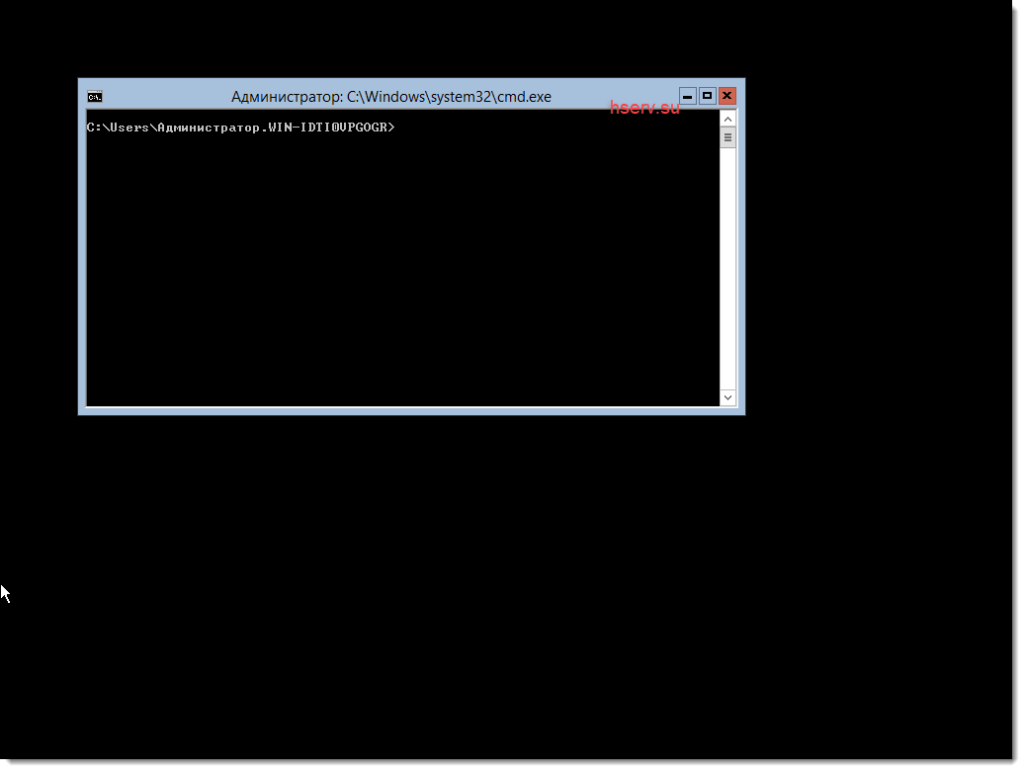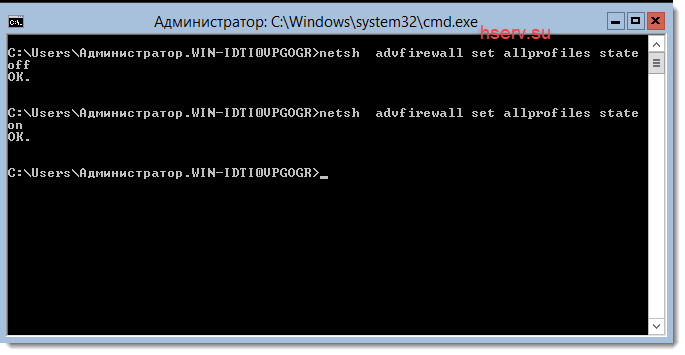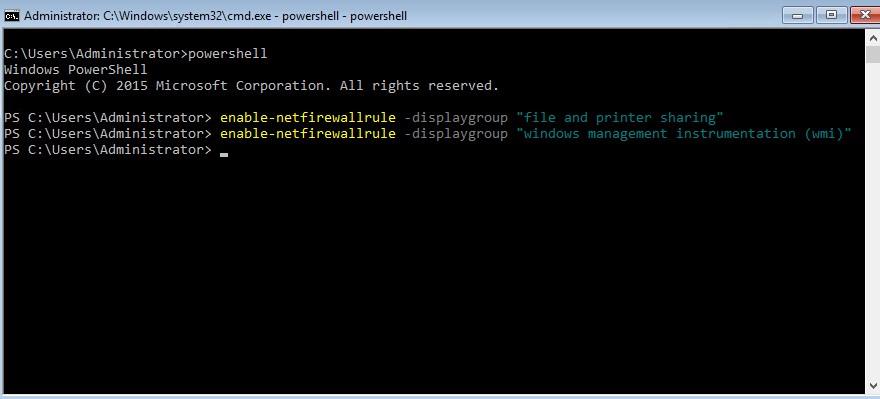Как вы знаете Server Core в Windows Server 2008 не включает в себя традиционный полный графический интерфейс пользователя (GUI).
Как и в стандартной (полной) установке Windows Server 2008, брандмауэр Windows включен по умолчанию, и большинство сетевых портов сразу после установки блокируются. Однако, поскольку основной задачей севера является предоставление некой услуги (будь то некая служба, файл, или что-то другое, что должно быть доступно по сети), вам необходимо разрешить определенный сетевой трафик на брандмауэре.
Одной из причин для открытия входящего трафика на брандмауэре – необходимость дистанционного управления сервером. Как уже упоминалось в предыдущих статьях, вы можете управлять Server Core с помощью локальной командной строки, дистанционно с помощью обычной MMC оснастки, через WinRM и WinRS, и даже через удаленный рабочий стол (хотя вы все равно получите обычное окно командной строки …)
В большинстве случаев после начальной конфигурации сервера, у Вас возникнет необходимость управления ролями и функциями, установленными на сервере, и вероятно, вы захотите использовать MMC-оснастку Administration tools. Есть три сценария удаленного управления через MMC:
- Роль сервера — когда роль сервера установлена на Вашем сервере, соответствующие порты открываются автоматически, позволяя вам удаленно управлять им. Никаких дополнительных настроек не требуется. Установив необходимые оснастки из Remote Server Administration Tools (RSAT) на вашей полноценной рабочей станции(сервере), вы сможете удаленно управлять сервером с Server Core.
- Сервер член домена — после того как сервер включен в домен, брандмауэр использует преднастроенный доменный профиль, который разрешает удаленное управление. Опять же, никаких дополнительных настроек не требуется.
- Сервер в рабочей группе — это сценарий, в котором потребуется внести изменения в конфигурацию брандмауэра. Если вы просто хотите задействовать все функции удаленного управления, можно использовать следующую команду:
Netsh advfirewall firewall set rule group=“remote administration” new enable=yes
Эта команда разрешает использование большинства методик удаленного управления и разрешает доступ к большинству оснасток MMC. Однако есть оснастки, удаленный доступ к которым настраивается дополнительно:
Диспетчер устройств (Device Manager)
Чтобы разрешить подключаться к диспетчеру устройств, нужно включить параметр политики «Allow remote access to the PnP interface».
Управление дисками (Disk Management)
Для этого на Server Core нужно запустить службы виртуальных дисков (Virtual Disk Service -VDS)
IPSec Management
Вы должны сначала установить удаленное управление для IPSec. Это можно сделать с помощью скрипта scregedit.wsf (он лежит в папке system32):
Cscript scregedit.wsf /im 1
Таким образом, доступ к большинству MMC оснасток удаленного администрирования, включается одним правилом на брандмауэре — Remote Administration firewall rules. Однако зачастую бывает необходимость предоставить доступ только ограниченному числу MMC-оснасток.
В брандмауэре существуют правила не для всех оснасток, в таблице перечислены существующие правила:

Чтобы включить любую из этих групп, нужно набрать команду:
Netsh advfirewall firewall set rule group=“<rule group>” new enable=yes
Где <rule group> — имя из приведенной таблицы.
Вы также можете удаленно включить их из брандмауэра Windows, запущенного в режиме Advanced Security. Для просмотра всех правил, просто сделайте сортировку по столбцу “Enable”:

Здравия всем! Для некоторых задач, к примеру сервер AD DS, хватает установки Windows Server без графического ядра. Для первоначальной настройки я предпочитаю отключать встроенный Firewall.
Заходим в наш сервер. Открывается консоль

Введем в консоли команду
netsh advfirewall set allprofiles state off
После этого сервер отключит Firewall.
Включение Firewall
Для включение обратная команда
netsh advfirewall set allprofiles state on
Заключение
Как видим из заметки отключаются все профили Firewall. Я не рекомендую оставлять сервер в таком виде в боевом режиме. Я использую этот режим, только для настройки сервера. После настройки сервера, я настраиваю Firewall и включаю его обратно.
Managing the Windows Firewall on Server Core can seem daunting for administrators unfamiliar with the Server Core installation of Windows Server. Unlike the full version of Windows Server, Server Core doesn’t include the traditional GUI (Graphical User Interface), so tasks like configuring the firewall require command-line tools or PowerShell. In this guide, we’ll explore how to effectively manage the Windows Firewall on Server Core, recommend some top tools and products, compare their features, and give you the best transactional advice on where to buy them. Whether you’re a system administrator or an IT enthusiast, by the end of this article, you’ll have a clearer understanding of how to manage firewall security on Windows Server Core with ease!

What is Windows Firewall on Server Core?
The Windows Firewall is a critical component of any Windows operating system, serving as the first line of defense against unauthorized access to your server. When you’re working with Windows Server Core, you’re interacting with a minimal installation that lacks a traditional graphical interface, relying on command-line tools and PowerShell for configuration.
Windows Firewall on Server Core works the same way as it does in other versions of Windows, but managing it becomes more of a challenge due to the absence of a GUI. Server Core, which is often used for running specific server roles (like DNS, Active Directory, or IIS), requires network security configurations to be handled entirely through command-line interfaces or remote management tools.
Key Features of Windows Firewall on Server Core:
- Port Filtering: Control inbound and outbound traffic by filtering specific ports.
- Rule-based Configuration: Define rules to allow or block traffic based on IP addresses, protocols, or applications.
- Logging: Maintain logs to monitor firewall activity.
- Remote Management: Manage firewall rules from a remote workstation using PowerShell or Windows Admin Center.
Why You Need to Manage the Windows Firewall on Server Core
Managing your Windows Firewall on Server Core is essential for several reasons:
- Security: A misconfigured firewall can leave your server vulnerable to attacks from external or internal threats. Proper management ensures your server is secure and only allows traffic that is absolutely necessary.
- Compliance: Many industries require servers to comply with security standards, and firewall rules play a crucial role in meeting these requirements.
- Network Optimization: Properly configured firewall rules can help ensure that only relevant traffic reaches your server, optimizing performance and minimizing unnecessary load.
Failing to manage your firewall on Server Core could lead to exposure to security risks, network slowdowns, or even compliance violations. Therefore, it is crucial to master the firewall management process to safeguard your server and network. 💼
How to Configure Windows Firewall on Server Core
Configuring the Windows Firewall on a Server Core installation can be done through PowerShell or the netsh command line tool. Here’s a simple guide:

Using PowerShell:
- Open PowerShell: Use PowerShell to manage your firewall rules.
- View Current Rules: Use the command
Get-NetFirewallRuleto list current firewall rules. - Enable/Disable Rules: Use
Enable-NetFirewallRule -Name "RuleName"to enable a specific rule orDisable-NetFirewallRule -Name "RuleName"to disable it. - Create a New Rule: Use
New-NetFirewallRuleto add a new rule. For example:powershell - Copy code
New-NetFirewallRule -Name "AllowHTTP" -DisplayName "Allow HTTP Traffic" -Protocol TCP -LocalPort 80 -Action Allow
Using Netsh Command:
- View Existing Rules: Use the
netsh advfirewall firewall show rule name=allcommand to list all existing rules. - Add a Rule: You can add a new rule using
netsh advfirewall firewall add rule name="AllowHTTP" protocol=TCP dir=in localport=80 action=allow. - Delete a Rule: To remove a rule, use
netsh advfirewall firewall delete rule name="AllowHTTP".
Both methods allow you to control the firewall rules on your server efficiently, but PowerShell is generally preferred due to its flexibility and scripting capabilities. 💻
Top Products for Managing Windows Firewall on Server Core
Managing Windows Firewall on Server Core can be streamlined with the right tools. Here are five recommended products that can help you configure and monitor firewall rules with ease:
1. SolarWinds Firewall Security Manager
SolarWinds Firewall Security Manager is a powerful solution that automates the management of Windows Firewall rules across your network.
- Use Case: Ideal for managing firewall policies across multiple servers.
- Key Features:
- Centralized rule management
- Automated compliance checks
- Change tracking
- Price: Starting at $1,200/year
- Pros: Excellent for large networks, user-friendly interface.
- Cons: Expensive for small businesses.
2. ManageEngine Firewall Analyzer
ManageEngine Firewall Analyzer provides a comprehensive solution for analyzing and managing firewall configurations across various devices.
- Use Case: Perfect for businesses needing firewall log analysis and rule configuration across multiple devices.
- Key Features:
- Real-time traffic monitoring
- Rule optimization suggestions
- Compliance reporting
- Price: Starts at $495/year
- Pros: Intuitive interface, customizable reports.
- Cons: Limited integrations with certain firewalls.
3. Netwrix Auditor
Netwrix Auditor offers robust auditing tools for tracking changes to firewall rules and network configurations on Server Core.
- Use Case: Ideal for tracking firewall configuration changes and ensuring compliance.
- Key Features:
- Real-time change tracking
- Detailed audit reports
- User activity monitoring
- Price: $2,195/year
- Pros: Strong reporting capabilities, easy integration.
- Cons: High pricing for small companies.
4. GFI LanGuard
GFI LanGuard helps you manage your network security, including the firewall, on Windows Server Core installations.
- Use Case: Ideal for vulnerability scanning and network security management.
- Key Features:
- Patch management
- Security audit tools
- Vulnerability scanning
- Price: Starts at $20 per device
- Pros: Comprehensive security management.
- Cons: Requires proper setup and training.
5. FortiAnalyzer
FortiAnalyzer is a centralized platform that helps to manage and analyze firewall logs and performance across large networks.
- Use Case: Excellent for enterprises that require detailed firewall and security log analysis.
- Key Features:
- Centralized log management
- Deep integration with FortiGate firewalls
- Advanced analytics
- Price: Contact for pricing
- Pros: Enterprise-grade analytics.
- Cons: Best suited for businesses already using FortiGate devices.
Comparing Firewall Management Tools for Server Core
| Product | Use Case | Pros | Cons | Price |
|---|---|---|---|---|
| SolarWinds Firewall Security Manager | Managing multiple firewall configurations | Centralized management, compliance checks | Expensive for small businesses | $1,200/year |
| ManageEngine Firewall Analyzer | Log analysis and firewall rule configuration | Real-time monitoring, rule optimization | Limited integrations with some firewalls | $495/year |
| Netwrix Auditor | Tracking changes to firewall configurations | Real-time tracking, audit reports | Expensive for smaller organizations | $2,195/year |
| GFI LanGuard | Vulnerability scanning and security auditing | Comprehensive security management | Requires proper setup and training | $20/device |
| FortiAnalyzer | Centralized log management and analysis | Advanced analytics, ideal for FortiGate users | Limited to FortiGate firewalls | Contact for pricing |
Benefits of Using These Products for Managing Windows Firewall
These tools bring significant advantages to your firewall management process:
- Centralized Management: Tools like SolarWinds and ManageEngine offer centralized dashboards that let you configure and monitor firewall rules across multiple servers at once, saving time and reducing errors.
- Automation: Many products, such as SolarWinds, automatically generate compliance reports and rule suggestions, making it easier for administrators to ensure their firewall settings meet industry standards.
- Enhanced Security: Real-time log monitoring and audit tracking help identify and resolve potential vulnerabilities in your firewall configuration quickly.
- User-Friendly: Most tools come with an easy-to-use interface, even for complex firewall management tasks, so you can focus on other important aspects of your network security.
Where to Buy: Best Places to Purchase Firewall Management Tools
Here’s where you can buy the products mentioned above:
- SolarWinds Firewall Security Manager: Buy Here
- ManageEngine Firewall Analyzer: Buy Here
- Netwrix Auditor: Buy Here
- GFI LanGuard: Buy Here
- FortiAnalyzer: Buy Here
FAQs
1. What is Windows Server Core? Windows Server Core is a minimal installation of Windows Server that does not include a graphical interface, reducing resource consumption and enhancing security.
2. How do I configure the Windows Firewall on Server Core? You can configure it through PowerShell using New-NetFirewallRule or netsh commands.
3. What are the best tools for managing Windows Firewall on Server Core? Some of the best tools include SolarWinds Firewall Security Manager, ManageEngine Firewall Analyzer, and Netwrix Auditor.
4. How do I buy these firewall management tools? You can purchase these tools directly from their respective websites, linked above.
5. Are there any free tools for managing Windows Firewall on Server Core? Yes, PowerShell and netsh are free and built into Windows Server, but they require more manual configuration compared to paid solutions.
By following these tips and using the recommended products, you’ll be able to efficiently manage the Windows Firewall on Server Core and secure your network infrastructure.
Read More >>>
- Managed Windows VPS Hosting: Best Providers, Benefits, and Pricing Explained
- Best Self Managed Windows VPS Hosting: Benefits, Top Products, & How to Buy
Reading Time: 4 minutes
In Server Core installations of Windows Server 2008 the Windows Firewall is enabled by default. This means it’s locked up by default and offers little weakness towards unfriendly administrators and users. When you want to do something with your Server Core box you might want to open up the Windows Firewall a little bit to allow certain types of traffic.
From the console
First let’s look at managing the Windows Firewall from the Console of your Server Core box.
Disabling the firewall
To completely disable the firewall you can use the following commandline command straight from the console of your Server Core box:
netsh firewall set opmode disable
I should point out you should avoid using this command because it eliminates the firewall as a security measure completely, which is a bad thing. Temporarily disabling the firewall might be useful to troubleshoot network connectivity though. The command to enable the firewall after you successfully troubleshooted the problem is:
netsh firewall set opmode enable
Opening up the firewall
There are three ways to open up the Windows Firewall from the console of your Server Core box, without compromising the security of the system all together. You can:
- Enable specific services
- Open specific ports or specific port ranges
- Allow specific programs
To enable service exceptions
The Windows Firewall in a Server Core installation of Windows Server 2008 comes with a couple of default firewall exceptions. You can enable these exception to allow specific types of traffic through the firewall. For example, to allow File and Printer Sharing you can run the following command:
netsh firewall set service fileandprint
If at any point you need help with the set service command just type netsh firewall set service which will show you some help. Extra command line switches may allow you to specify another firewall profile and/or specify a firewall scope. (all, subnet or custom)
To open specific ports
If your situation demands you open up specific ports to allow incoming traffic through your firewall you can add specific port openings in your firewall. You can specify whether the traffic is UDP or TCP, which port number you’d like to open and which name you’d like to give your portopening, like this:
netsh firewall set portopening protocol=TCP | UDP port=PortnumberHere name=AnyNameHere
If at any point you need help with the set service command just type netsh firewall set portopening which will show you some help. Extra command line switches may allow you to specify another firewall profile and/or specify a firewall scope. (all, subnet or custom)
To allow specific programs
Another way to open up the firewall is to allow specific programs to communicate with the outside world. The Windows Firewall will allow any traffic to the executables you specify. Again you can also specify a name for the rule. Use this command to allow specific programs:
netsh firewall set allowedprogram program=FullPathToExecutable name=AnyNameHere
If at any point you need help with the set service command just type netsh firewall set allowedprogram which will show you some help. Extra command line switches may allow you to specify another firewall profile and/or specify a firewall scope (all, subnet or custom)
Using Advanced Firewall commands
Alternatively you can use the spanking new Advanced Firewall, which enables you to control incoming as well as outgoing traffic, allows you to edit the firewall configuration in offline mode, (so you can change the settings, without committing any changes yet) monitor connections and import/export your firewall configuration.
There’s a nice webpage with more information on the Advanced Firewall functionality here. It shows you how to change settings through the commandline and how to change them using Group Policies.
Through Group Policy
Another way to manage the Windows Firewall on your Server Core box is to use Group Policy Objects. You can edit the local group policy of your Server Core box from a remote Windows box, which is useful if you want to set the settings in a graphical user interface for small amounts of Server Core boxes.
Alternatively you may harness the power of Active Directory, to change the settings on loads of Windows Server 2008 (Server Core) boxes automatically and without loads of administrative effort.
The settings for Windows Firewall are located in the WindowsFirewall.admx Administrative Template are located in the Computer Configuration part of the policy. The template includes the following settings for both the Standard Profile and the Domain Profile:
- Allow Authenticated IPSec Bypass
- Allow ICMP exceptions
- Allow inbound file and printer sharing exception
- Allow inbound remote administration exception
- Allow inbound Remote Desktop exceptions
- Allow inbound UPnP framework exceptions
- Allow local port exceptions
- Allow local program exceptions
- Allow logging
- Define inbound port exceptions
- Define inbound program exceptions
- Do not allow exceptions
- Prohibit notifications
- Prohibit unicast response to multicast or broadcast requests
- Protect all network Connections
Concluding
Completely disabling the Windows Firewall is a tempting way to circumvent the security measures in Windows Server 2008. As an alternative this blogpost shows you how to selectively and gradually open up the Windows firewall from the console of your Server Core box. For the faint of heart I included some hints to edit the local group policy.
Enterprise admins will probably already have a Windows Firewall policy in place, which they only have to adapt to manage Windows Server 2008 Server Core boxes.
Further reading
Group Policy Settings Reference Windows Server 2008 Beta 3
Command line firewall configuration
Netsh Command Line Switches And Examples For Windows 2003 And Windows XP
Wonderful Netsh
Networking and firewall
Managing Windows Firewall with Netsh
Improvements to the Windows firewall in Vista
How to configure the new Windows Server 2008 advanced firewall MMC snap-in
Still Very Much Alive and Kicking – netsh
New Networking Features in Windows Server 2008 and Windows Vista
The New Windows Firewall in Windows Vista and Windows Server 2008
Using the Netsh Advfirewall Command-Line Tool
Disclaimer Beta Software
The information on this webpage applies to software from Microsoft that was in testing phase but utilizable by experienced users by the time the webpage was written. This software has not been released for sale, distribution or usage for the general public. The information on this webpage and the beta software are provided «as is» without warranty of any kind, either expressed or implied, including, but not limited to, the implied warranties of merchantability and fitness for a particular purpose.
Provide feedback
Saved searches
Use saved searches to filter your results more quickly
Sign up
Appearance settings
